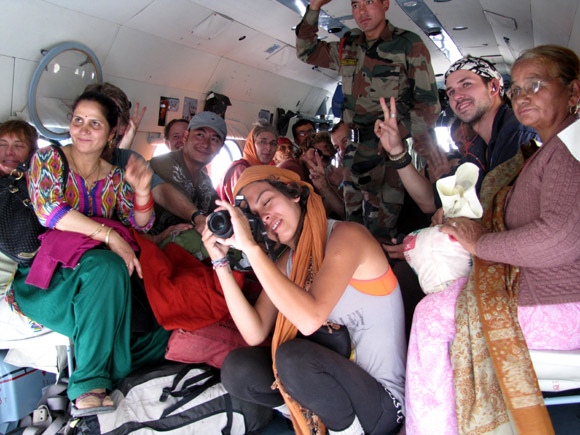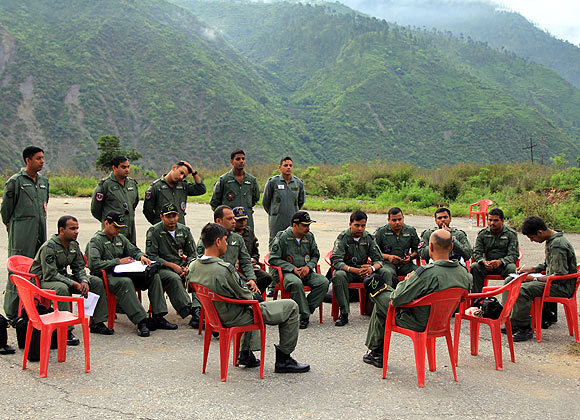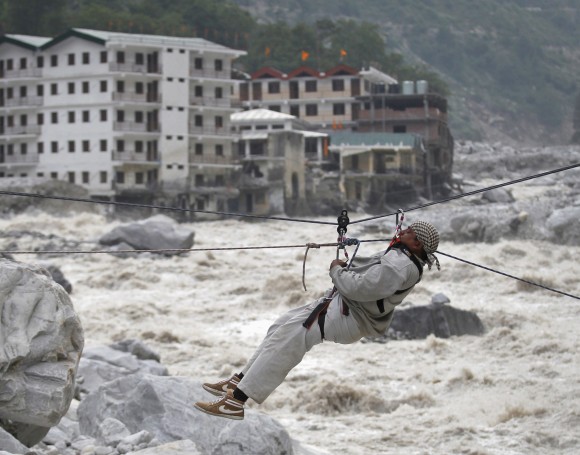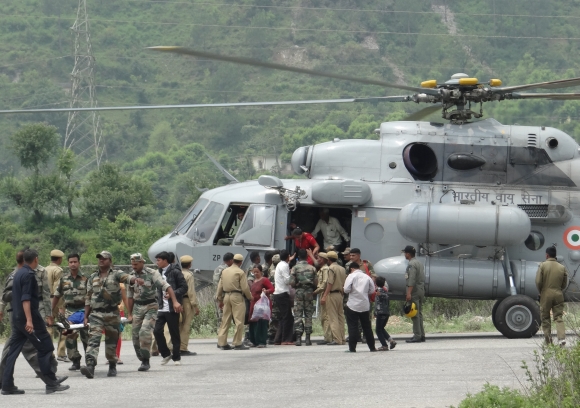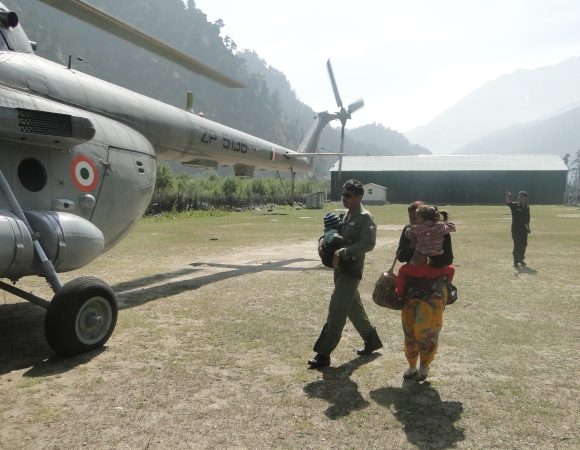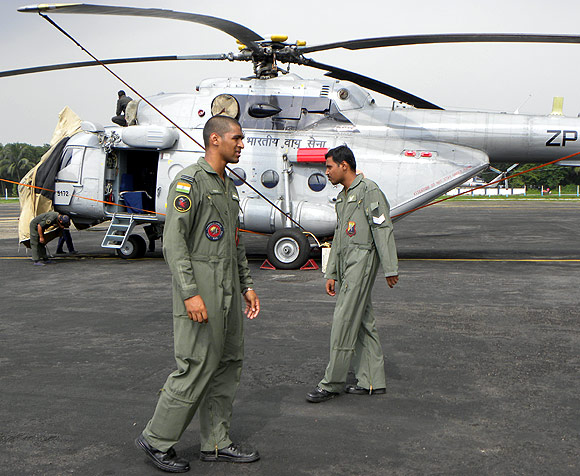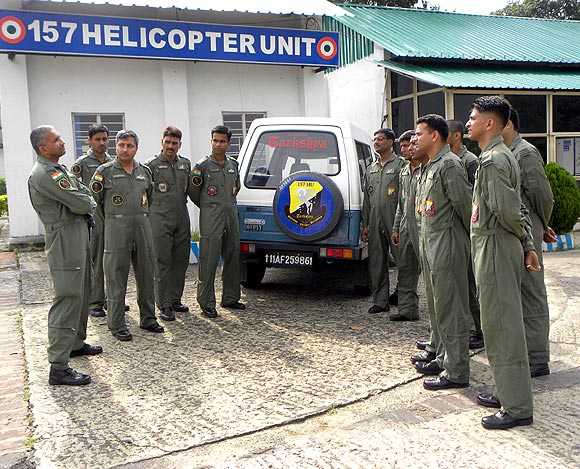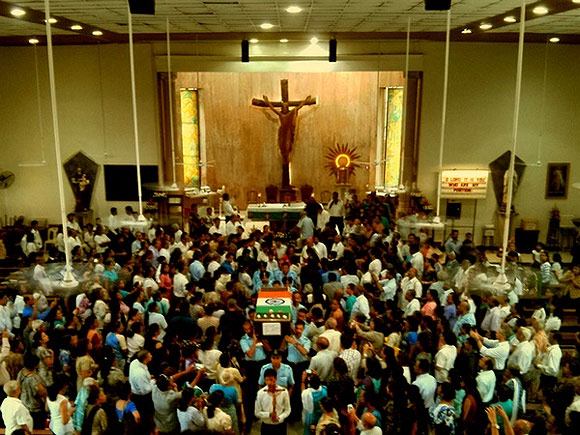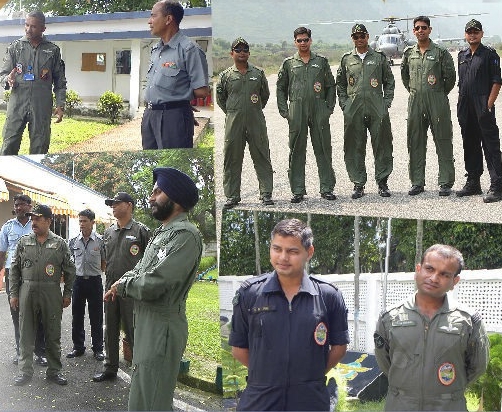 | « Back to article | Print this article |
Saviours in the Valley of Death
Pilots and crew of the Indian Air Force fought a valiant battle against Nature to save thousands of lives in Uttarakhand's treacherous valleys, scripting India's greatest rescue operation.
Archana Masih met some of the IAF's heroes.
As furious rivers swallowed roads, homes, mountains and people in Uttarakhand, in another corner of India, at an Indian Air Force station in Bagdogra, West Bengal, a group of officers and men were preparing to leave on an unparalleled mission.
Flight Lieutenants Vivek Jaiswal and Vijay K Pal, two young IAF officers with two and three years of service respectively, were among those called for an emergency briefing at 7 pm.
They had to leave at 4 am the next morning. The officers and men were asked to pack kits for 14 days, but this was extendable.
'Don't think you will be back in 7, 10, 15 days,' was the stern instruction, 'you will be there till the operation is over.'
With hardly any air strips in Uttarakhand's vastly destroyed hills and valleys, the IAF crews did not know where exactly they would operate from. The only certainty at that time was that they had to fly out in their Mi 17 V5 helicopters the next morning.
Back in their rooms, they packed their kits -- putting in their overalls, night clothes, shaving kits, mosquito repellant, some cash -- as they prepared to set out on what would turn out to be the IAF's biggest disaster relief mission.
When their choppers landed en route at Bareilly, Uttar Pradesh, their detachment commander, Group Captain M K 'Mikee' Yadav, was told to set base on a disused air field in Dharasu to rescue thousands of Indians stranded in the Gangotri sector.
A veteran of search and rescue operations in Sikkim, Assam and Bihar, Group Captain Yadav also served in the United Nations Peacekeeping Mission in Sierra Leone, one of Africa's most volatile countries, where on a mission his chopper was shot at by militants, forcing his helicopter to crash-land in absolutely hostile territory.
This time, the hostility was of a different kind -- it came from Nature, which has shown time and time again that it can be a destroyer like none other.
Please click on NEXT to read MORE...
Battling rough weather and terrain to rescue thousands
In an area ravaged by Nature's fury, the first of many challenges faced by the IAF teams was to set up a functioning air field to launch operations.
The grass on either side of the airfield was 5 to 6 feet high and was probably used to dump dead animals because of which the entire area stank.
On June 21 the first thing the six officers and about 20 men -- among the first to arrive in two helicopters -- had to do was to clear the runway. An army component also arrived the same day. A bulldozer from the Border Roads Organisation was organised which worked all night cleaning both edges of the runway.
But at 1 am that night, one of the dozer's tyres burst...
In the middle of the night, with the help of the local deputy superintendent of police, a local mechanic was woken up to fix the tyre. The dead animals were buried and men and machine worked through the night to ensure that by 6 am the runway was cleared.
Since road connectivity to the airfield was destroyed, the IAF had to think quickly how to transport fuel.
Solution: Two empty fuel tankers were flown in -- one by one -- in a Mi 26 helicopter from Saharanpur, Uttar Pradesh.
By 9.30 am, the first C 130 J aircraft arrived and defueled its enormous tanks into the bowsers brought in by the Mi 26. It did two more such shuttles, giving the IAF crews sufficient fuel for operations that day. Subsequently, road connectivity was restored for fuel tankers to reach the airfield.
Thirteen aircraft and crew from diverse Air Force units from across the country carried out the rescue effort in Dharasu. Five-six civilian aircraft also bolstered the rescue effort.
Pitched against rough weather, treacherous terrain and entrusted with the enormous task of rescuing thousands and thousands of stranded pilgrims -- the 27 officers and 70 airmen in Dharasu evacuated 5,488 people in that sector alone in one week of intensive operations.
Please click on NEXT to read MORE...
'What an enormous challenge it was!'
Their days would begin at 4.30 am and go on till there was light enough to carry on rescue operations. A member of the crew points out when they operated 121 sorties in a single day to rescue people.
Pilots and men were given accommodation in whatever local hotels and guest houses were available. Some spread their sleeping bags on the floor and crashed after a hard day's work. Tents were pitched on the airstrip for men and equipment and for providing shelter for the civilians.
"It was as if tents were rising up in the middle of a forest; sometimes they would blow away with the downwash (strong airflow caused by helicopter blades). 10, 15 aircraft were landing and taking off from a narrow strip -- one helicopter would take off, another would be making an approach for landing," says another member of the ground crew.
Briefings and debriefs happened on the tarmac; there was no crew room which the officers and men were used to at air force stations.
Aircraft too have designated hangars at IAF stations, but these helicopters had to be parked in the open on these makeshift landing strips.
Back at the air force stations, flying activities are known a day in advance; but here the officers and men knew they had to carry out as many rescue missions as possible depending on the weather that day.
Many pilots flew like they had never before -- doing 80 to 90 sorties -- much more than what they flew in 3-4 months.
"When we landed there the first day, there was nothing -- from nothing, we built up a fully functional system for our operations," says Sergeant Raspreet Singh, a flight engineer from Jammu posted in Bagdogra, with a-year-and-a-half of flying experience.
Braving daily operational and weather difficulties, the IAF crews in the first 15 days flew 2,140 missions and evacuated 19,600 civilians in Uttarakhand.
"It was hectic, perhaps such a situation must not have been seen even in war. But we were happy we got an opportunity to save lives. Once the rescued pilgrims stepped out of the aircraft and walked away, there was not one that did not turn back and look at us with appreciation," adds technician Shashi Kapoor, who looks after aircraft maintenance and is a 24 year veteran of the IAF.
"Bahut tagda challenge tha (what an enormous challenge it was)," he says.
Please click on NEXT to read MORE...
Weather was the worst adversary
The biggest challenge was the weather. Visibility was low; the valleys were very narrow. It was also a new area of operation and all pilots, however experienced, will tell you that no amount of briefing is good enough till one actually flies in the area.
Although risk is inherent in any air operation, it was not an easy task to operate in treacherous valleys which had other aircraft -- including civilian helicopters -- conducting rescue operations in the same space.
"We knew the exact sequence and position of each helicopter. We had named certain points in the valleys and civilian aircraft were also asked to apprise us of their location. Specific R/T calls were to be given while entering and exiting the narrow valley. Otherwise, if you miss a position report given by a helicopter, you could end up in a mid air collision," says Group Captain Yadav, who along with his crew was operating in Uttarakhand for the first time.
A native of Jhunjhunu, Rajasthan, Mikee Yadav is the lone member from his family to join the armed forces. As the leader in Dharasu, he would take off first every morning to check the valley and the weather, clearing the way for his "boys" to begin the cycle of rescue ops for the day.
When he talks about his "boys" -- how they worked tirelessly, thought innovatively and worked as a unit -- the pride in his voice is palpable. Every officer, engineer, technician, ground staff or administration support staff we spoke to, had been part of rescue ops before, but all of them agreed that the situation in Uttarakhand was something they had never seen before.
Aircraft -- both from the helicopter and transport fleets -- were quickly marshalled from different IAF bases for an operation that needed swift execution and tireless effort.
The C-130 J, a transport aircraft was used as an airborne communication relay centre, giving crucial weather updates from its greater height to helicopters operating at lower altitudes.
Flying Officer Michael Verghese, a young pilot with a year-and-a-half in service, who was part of the operations in the Kedarnath-Badrinath sector, says the weather was the worst adversary.
Please click on NEXT to read MORE...
'Response in a natural disaster cannot be random'
"The valley could be open on one side and blocked by clouds at the other end. High tension wires and the terrain also posed difficulties," says Flying Officer Verghese, explaining that the load carrying capability of a helicopter largely depends on the altitude it is operating at.
Makeshift helipads were constructed between the hills -- sometimes on a school ground or on a patch of land by a river -- many created by army teams on focal points where people could assemble. At certain helipads, the queues of those waiting to be evacuated would run into kilometres.
The turnaround time for the helicopters was about 5 minutes which included downloading the rations and taking in passengers, who had been prioritised according to their condition by the army units on ground.
"When a natural disaster happens there is chaos and the response should not be random," says Wing Commander Apoorv Verma, the commanding officer of a unit that operated from Gauchar, Uttarakhand. "It has to be optimised to be effective and that is where our training and regimentation comes in."
"People are not aware of the number of rescues the IAF does over and over again," he says. "It is phenomenal."
In Maneri and Harsil, about 30 and 40 kilometres from Gangotri respectively, two of the several locations where the IAF was airlifting stranded people, the scenes were pathetic. Some people had reached the helipad by foot -- their feet were swollen, their toes were bleeding, their broken footwear was held together by makeshift strings or twines. Some were so weak and unable to walk that they were carried by army and ITBP personnel into the aircraft.
Please click on NEXT to read MORE...
'The people we rescued said they got a second life'
The pilgrims were mostly elderly and all they wanted was to be inside the aircraft.
In sheer desperation, they would run towards the aircraft in the early days of the evacuation. Army and para military personnel had to keep them in check.
On one of the sorties, one lady clung to the ladder and refused to let go because her husband did not find place in the aircraft. 'We survived such a calamity together and you are separating us now. Either you leave me behind with him or you take him inside,' she told them.
The crew requested another man to get off and take the next shuttle so that the couple could fly out together. There are many such human stories of desperation and hope that the IAF crews encountered as they went about the rescue efforts tirelessly.
"As soon as the aircraft used to lift up, many would start crying in relief," remembers Sergeant Prabha Shankar.
Non Combatant personnel, M R Haque's eyes become moist as he recounts the horrors of what the survivors told him. Having served 22 years in the IAF, including a stint at Thoise, the country's highest air force base in the Siachen glacier, never before had he known the ghoulish depths human beings are driven to in their fight for survival.
Survivors told him about the family that waited on top of corpses for days before they could be rescued; a child left hanging from a tree who died crying for water; people squeezing water out of filthy socks so that they could get a few drops to moisten parched lips...
"The people we rescued said they got a second life because of us," says Sergeant P V Sreekanth who like M R Haque was part of the crew that flew from Barrackpore to carry out rescue operations in the Kedarnath-Badrinath valleys.
"An old man came and hugged me. He did not say anything," says the young Flying Officer Michael Verghese, "I will remember that hug for the rest of my life."
Please click on NEXT to read MORE...
'Jai Hind Sir! Morale is high'
Back in his unit at Barrackpore, India's oldest cantonment where Mangal Pande lit the first sparks of the First War of Independence in 1857, Flying Officer Michael Verghese is a picture of quiet dignity.
When he was picked to go to Uttarakhand, he did not realise the magnitude of the operation -- that it would be a rescue effort that had never taken place before.
Neither did he know that the rescue would claim the lives of five of his mates. Three of whom he used to stay with in the temporary accommodation in Gauchar, Uttarakhand.
On June 25, at around 1.15 in the afternoon, a helicopter commanded by Wing Commander Darryl Castelino, a qualified flying instructor with almost 4,000 hours of flying, went missing.
Just a couple of hours before, he had sent an sms to a senior officer saying; 'Jai Hind sir! Morale is high. All ops normal.' But now, the news did not seem good.
Immediately, efforts were made to locate it, aircraft were launched, civil authorities were pressed into service. About three hours later, the aircraft was sighted. It had crashed.
Along with the five-man IAF crew, 15 Indo Tibetan Border Police and National Disaster Management Authority personnel perished in the mishap.
Members of the 'Garuds', the IAF's Special Forces, reached the site of the crash and relayed the news no one wanted to hear.
Just the previous night, after a long day of flying, Flying Officer Verghese was chatting with the other two young officers -- Flight Lieutenants K Praveen and Tapan Kapoor.
Flight Lieutenant Kapoor had left a job with Indigo Airlines to join the IAF; Flight Lieutenant Praveen was the best passing out cadet in his batch... Both extremely bright officers with a promising life and career ahead.
Please click on NEXT to read MORE...
'The show will go on'
Like young men anywhere, that night they were discussing what apps to download on Praveen's new iPad; about Tapan's New Year eve holiday plans in Goa, what they would do when they got back to base...
Now they were no more, and along with his senior officer Squadron Leader Suchit Agarwal, Flying Officer Verghese had flown to the Hindon air base with the five bodies.
In Barrackpore, where the families of Wing Commander Castelino, Flight Gunner Sergeant Sudhakar Yadav and Flight Engineer Junior Warrant Officer A K Singh lived, it was Commanding Officer Apoorv Verma's responsibility to break the tragic news to their families.
Wing Commander Castelino lived next door to him and together they had raised a new unit from scratch a-year-and-a-half earlier.
"What poise these ladies had. I did not hear any of the ladies say 'Why me?' It speaks volumes of the dignity of the families," Wing Commander Verma says, sitting in his quiet office at the Barrackpore air force station, near Kolkata.
It was the first tragedy to hit this young unit, where a majority of officers are in their mid 20s and early 30s. Members from the 157 Helicopter Unit attended the funerals of their fallen colleagues and seemed stoic in their grief when we met them.
"Sad and determined," describes an officer about the mood at their Barrackpore base. After news of the crash sank in, the consensus among the officers and men was to get a second aircraft in line to replace the one lost so that rescue efforts could continue unabated.
The day after the tragedy, Air Marshal R K Sharma, AVSM, VM, Air Officer Commanding in Chief, Eastern Air Command, under which the Barrackpore air station operates, arrived to boost the morale of the unit and flew with them.
"It was our way of showing that the show will go on," says Wing Commander Verma who flew with each of his crews after the tragedy to keep their chin up.
In Dharasu, about 170 kilometres from the crash site -- Group Captain Mikee Yadav ensured that his boys operated as normally as they would any other day.
The briefing at the airstrip was conducted at 5.30 am. Mikee Yadav ensured that each pilot flew at least one sortie on the day after the crash.
"We had to make sure that faith is not lost," he says.
Please click on NEXT to read MORE...
A Few Good Men
Wing Commander Castelino had flown at high altitudes, over plains and over seas. In their crew room in Barrackpore, his mates tell me about men who the rest of India knew only through news reports.
Flight Lieutenant Tapan, 27, was extremely popular. So many of his course mates flew in from wherever they were posted, to attend the funeral. "He was one officer who never said no," says Flight Lieutenant Akansha, the sole lady technical officer in the unit.
"Praveen was the idol of Madurai. Even when he was in school, he knew five foreign languages," says another officer.
On the day of Flight Lieutenant Tapan Kapoor's funeral, shops in Chandni Chowk in Old Delhi, where he lived, downed their shutters in respect.
In Madurai, ordinary folk mourned Flight Lieutenant K Praveen, 27, the only child of a single mother.
In Amethi and Sant Kabir district in Uttar Pradesh, the villages of Junior Warrant Officer A K Singh and Sergeant Sudhakar Yadav; their villages were plunged in unspeakable grief.
The Mumbai church, which conducted Wing Commander Castelino's funeral mass, was packed to capacity by mourners of all faiths. Banners saluting him lined the street.
As we talk of men who died on that rescue mission, in that crew room occupied by young officers in overalls, I ask Flying Officer Verghese if he had any pictures of their team in Uttarakhand.
Just a day before the crash, the entire Barrackpore team in Uttarakhand had taken a group photograph with their helicopters at the Gauchar airstrip, he tells me.
"The camera too perished in the crash."
This was a grieving station, I had known this before coming to Barrackpore but the manner in which these young men and woman were coping with grief was admirable. This was their best tribute to their fallen mates.
Please click on NEXT to read MORE...
The great fightback
Never before had such a large number of civilians in distress seen the Indian Army and Indian Air Force work so up, close and personal.
There were many who had never seen a helicopter before or had pilots, crew and personnel live in their small villages. They had not seen them work round the clock against such brutal weather, risking their lives to save other lives.
They called them the saviours and gave them their blessing. They brought them food at the airstrips. A shopkeeper in Dehradun refused to take money from IAF officers for their phone refill voucher.
'If I take money from you people, it will be a sin on my part,' remembers an officer of what the shopkeeper told him. A local driver stayed up till very late on the day of the crash -- 'This is the least I can do,' he said.
While they talk about their own work done, the officers and men do not fail to mention the commendable job done by the army and para military. How army officers and troops set up makeshift hospitals and took care of the needs of the pilgrims once they were rescued. How the local administration cooperated with the military.
The senior officers make sure that it was not them alone but other IAF personnel like Madhu Chetri, the young non commissioned lad from Shillong, who made 400-500 cups of tea every day on a small stove for those at the airstrip. Or Corporal SPA Basha, the Andhra native, who woke up earlier than the rest to ensure that local transport was there in time to take crews to the makeshift airstrip.
Please click on NEXT to read MORE...
The roll of honour
Now when they look back, they say they are proud of what they did, but also grieve about the tragedy that befell so many.
"When we chose to fly helicopters, we knew helicopter pilots save lives,"says Flight Lieutenant Praveen Jaiswal. "It felt good to actually do that.
Remembering their departure from Dharasu, Flight Lieutenant V K Pal remembers a boy called Ayush who used to come with tea and biscuits -- waiting till the last sortie each day.
"When he came to know we were leaving, he was very sad and told us he would also go back to his village," remembers the officer who is from Mohali. Ayush told him he wanted to join the air force and Flight Lieutenant Pal's parting words to him were 'Study hard and join the air force.'
In Uttarakhand's darkest hour, these men not only rescued and brought relief; they also won hearts and changed minds.
Image: Bottom left: Corporal SPA Basha, Sergeant Prabha Shankar, Non Combatant Employee Madhu Chetri, Technician Shashi Kapoor and Sergeant Raspreet Singh from the Bagdogra Air Force Station. Photograph: Seema Pant/Rediff.com
Bottom right: Flight Lieutenants VK Pal and Vivek Jaiswal were part of the rescue ops in Dharasu. Photograph: Seema Pant/Rediff.com
Top right: Group Captain Mikee Yadav [centre] with his boys at Dharasu; Photograph: Indian Air Force
Top left: Wing Commander Apoorv Verma talking to Non Commissioned personnel MR Haque in Barrackpore. Photograph: Seema Pant/Rediff.com

